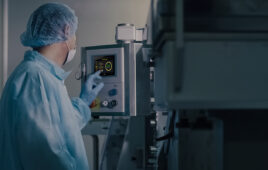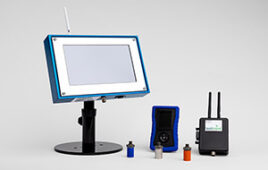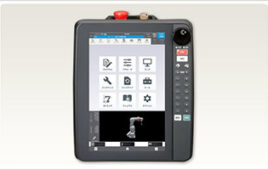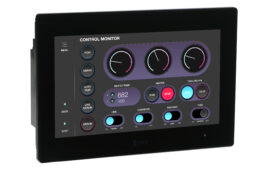Industrial automation systems can incorporate consumer-grade tablets as powerful HMIs, using a specialized component to provide a secure grip and maintain safety.
By Luiz Shida, IDEC Corp.
Industrial automation applications are becoming more sophisticated and can take advantage of many features available in consumer-grade mobile smartphone and tablet devices. End users benefit from high-resolution visualization, familiar touch interfaces, and the ready availability of economical hardware. However, to use these devices safely in a factory environment there needs to be some consideration about how users can securely hold and use these devices. A new component is available, created specifically to address these concerns.
A more mobile HMI
For many years, automated industrial plant and facility designs have required operators to perform their work standing in front of a fixed control panel with a dedicated human-machine interface (HMI) display, or perhaps using a specialized teaching pendant for certain machinery and robotics. Typical examples include machines, conveyors, robotics, automated guided vehicles (AGVs), and any type of production operations.
With the increased availability of HMI apps and web browser-based methods for operators to interact with automated equipment, it is now possible for one tablet to replace many control panels worth of buttons and indicators. Wireless Ethernet and Bluetooth provide reliable mobile connectivity. When HMI functionality is combined with mobility, users benefit from the best of both worlds, experiencing more visibility and greater operational access.
Mobile HMI devices can do many other useful things also, such as displaying manuals and drawings, showing reports and trends, and even supporting videoconferencing and messaging methods so operational teams can work better together. Furthermore, a growing number of industrial internet of things (IIoT) smart devices are generating a large amount of information, which is much more useful when it can be conveniently viewed on a mobile device right where operators need it.
Freeing operators from fixed-location HMIs lets them move around equipment while keeping important operational information right at their fingertips. However, this is only a reality if the mobile HMI can be safely and reliably carried. Another consideration is that many types of operational equipment require hardwired safety related devices like emergency stop (e-stop) buttons or enable switches. Due to these and other issues, designers have often struggled to find the best way to use modern mobile HMIs, while including industrial-grade usability and safety features.

Consumer tablets are useful for industrial automation projects, but only if they properly incorporate safety systems and are protected with a component like the unique IDEC HT3P Safety Commander.
Merging consumer devices with industrial safety
To simplify the task of using tablets effectively and safely in industrial settings, a mobile device holder has been developed. The face of the holder uses diagonally sliding adjustable grippers to securely hold tablets ranging from 8- to 11-inches in diagonal size. The back side of the device features an ergonomic hand grip and strap, arranged to be suitable for both right- and left-handed use. Another carrying option is a neck strap, and a wall-hanging bracket lets users securely store the holder when it is not in active use.
Users can insert and remove their own tablets into and out of the holder at will, or a built-in key-lock lets users secure the tablet in place for longer term use. A patented mechanism allows the display to be rotated between vertical/portrait and horizontal/landscape orientation as needed to best match the application in use. The holder has been tested to 1.2 meters for drop resistance, and resists water splashes and dirt with an IP54 protection rating.
Wired connections
Although wireless connectivity and battery operation are fundamental tablet features, using them with industrial applications means there needs to be provisions for power and safety wiring connections. Some applications may be able to use the holder without a wired connection, but in other cases the included and connectorized 5-meter cable can be used to provide wired functions. Users can move around with the tablet installed into the holder, much as they would with a traditional industrial wired pendant controller.

The IDEC HT3P Safety Commander includes hardwired safety buttons, a charging port, and multiple holding and mounting options, making it practical to use a tablet for industrial automation applications.
Recharging mobile tablets on the factory floor presents challenges for many applications, as users need to remember to charge the device in a protected location. The tablet holder solves this by incorporating a USB Type-C port so it can maintain its charge constantly while mounted in the holder. Tablets can be semi-permanently installed in this manner, or personnel can install their own tablets when and where they are needed for their work. This is particularly useful for maintenance personnel.
Safety functionality is provided by two hardwired features incorporated into the device. A hardwired e-stop button with an LED indicator is available for integration into any equipment safety circuit, typically required when any personnel are working near or around equipment with moving parts. Because the e-stop button is available right at the tablet, a user can activate it quickly.
Many types of equipment operated with workers nearby—especially robotics—require an enable switch, which is also commonly known as a ‘dead man’s switch’. For this purpose, the holder includes a three-position hardwired enable switch. This requires the operator to positively hold the enable switch, such as for hold-to-run control functionality. Letting go of the switch for any reason stops the equipment.
Tablets enable flexible automation solutions
Tablets offer more capabilities than other HMI methods and make IIoT data accessible, and they make it possible to avoid installing multiple fixed-location control panels, HMIs, and even PCs on the plant floor. However, designers have struggled with inelegant methods for incorporating tablets with industrial automation, and may not have found good ways to provide proper safety provisions.
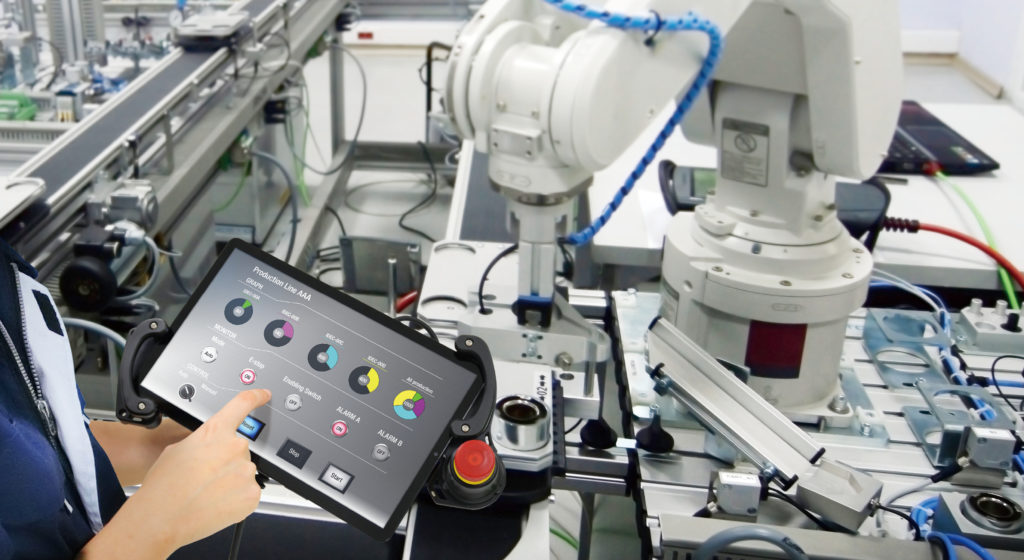
Modern tablet-based HMIs using the Safety Commander provide an improved operator HMI experience, while meeting all hardwired e-stop and enable switch requirements.
Robot and AGV applications are examples of moving equipment that may sometimes require an operator to work in the vicinity. A tablet equipped with a holder lets the operator experience improved visualization as compared to traditional fixed HMIs. Furthermore, the holder enables designers to maintain compliance with ISO/IEC safety standards and requirements as operators are protected by the wired e-stop and hold-to-run enable switch functions.
Some systems, such as long-distance conveyor systems or wide-ranging production lines, require infrequent operator input. In these types of applications, designers were faced with installing multiple operation panels along the length of the line to provide HMI functionality. A better solution is to install holders and wall-hanging brackets at multiple locations along the line. This enables operators and maintenance personnel to quickly connect and use their own tablet when and where it is needed so they can work effectively without moving back and forth to an inconvenient fixed HMI. The result is improved operator efficiency and reduced control panel costs.
Modern tablets deliver a superior HMI experience, providing operators and maintenance personnel with the flexibility to work with automated equipment in a more accessible way as compared to fixed panels. Unfortunately, until now it has been difficult and impractical to integrate these consumer-grade tablets into industrial-grade systems.
This has changed with the introduction of a new type of holding device optimized to provide a robust tablet carrying method, suitable physical protection, and hardwired safety connectivity. Designers now have an option to incorporate inexpensive tablets at one or more locations for equipment, manufacturing, and processing applications. This enables users to safely move around equipment, efficiently interacting with it for visualization, control, and IIoT functionality.
IDEC Corp.
www.idec.com
Filed Under: Flanges • supports • mounts • brackets, Displays • HMIs • operator interfaces • monitors

